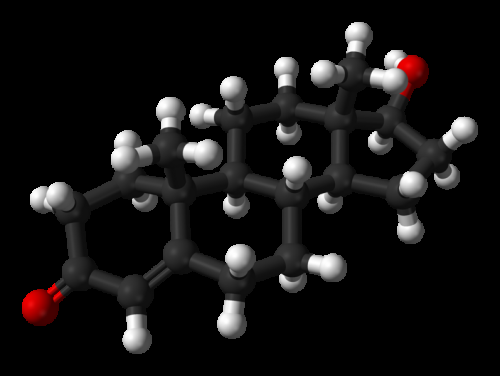Ball-and-stick model of the testosterone molecule, C19H28O2, as found in the crystal structure of testosterone monohydrate. Credit: Ben Mills/Wikipedia
(Medical Xpress)—A pair of researchers, one with Stanford University, the other Barnard College, has published a Policy Forum piece in the journal Science, calling for changes to the way female athletes are judged on their fitness to compete as women in major sporting events. Katrina Karkazis and Rebecca Jordan-Young note that thus far there have only been two serious studies done on the topic and they came back with conflicting results, which suggests that sports organizations that use testosterone levels to exclude women from competing with other women are unfair.
Because some males have attempted to compete as female athletes over the years, major sporting promoters began testing those who entered competitions, first via visual inspection of genitals, than later, by taking blood tests and checking for X and Y chromosomes. But such tests were eventually discredited as a means of validation. In 2011, the IAAF set a limit on testosterone levels as the sole means of qualification of competing as female and that policy has generated some heat from some quarters as some athletes have been banned from competing and others have undergone surgical procedures to correct the problem.
As Karkazis and Jordan-Young note, the two studies that have been done that underlie decision making by such organizations as the IAAF and IOC, include one called the GH-2000 where 234 female athletes (and 446 males) competing in Olympic events were tested for growth hormones and also their testosterone levels. The researchers discovered that 13.7 percent of the women tested showed testosterone levels that were considered to be above the norm, and that 4.7 percent had levels so high they were considered to be in the male range (males are typically believed to have on average, levels that are ten times higher than women.)
The other study was conducted during the 2011 World Championships leading up to the Olympics, where 849 female athletes had their testosterone levels checked—they found that just 1.5 percent of those tested had levels that were considered to be higher than the normal range for women.
Karkazis and Jordan-Young suggest these discrepancies, plus other problems with the studies themselves (such as the fact that one study included only women and focused only on women in track and field and the other study relied on samples that were taken from athletes shortly after they had competed when their testosterone levels were are their highest) make testing in this way "grossly unfair" and should be halted and that a new method of testing be found which includes focusing on which gender individuals identify themselves as.
More information: Debating a testosterone "sex gap" Science 22 May 2015: Vol. 348 no. 6237 pp. 858-860. DOI: 10.1126/science.aab1057
Abstract
Sexual dimorphism of testosterone (T) in elite athletes was at the center of a recent case at the "Supreme Court of Sport," the Court of Arbitration for Sport in Switzerland, after teenage Indian sprinter Dutee Chand challenged a sports policy regulating competition eligibility of women with naturally high T. The idea of a "sex gap" in T is a cornerstone of this policy (1). Policymakers infer that men's higher T is the "one factor [that] makes a decisive difference" between men's and women's athletic performances (2)—so that women with naturally high T may unfairly enjoy a "massive androgenic advantage" over other women athletes (2). We report on an emerging scientific debate about whether the sex gap in T applies to elite athletes.
Journal information: Science
© 2015 Medical Xpress

.jpg)


















